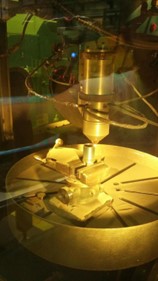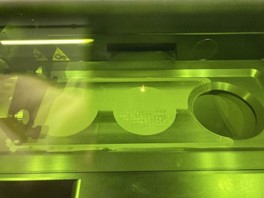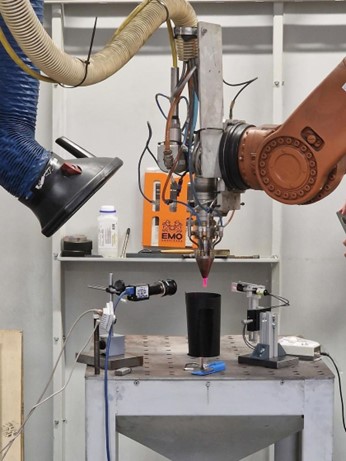Slovenian expertise: advanced laser metal 3D printing monitoring system
12. Feb 2024
Digital transformation
The DIGI-H-AM system consists of a web application for monitoring the entire hybrid additive manufacturing process, a central data warehouse and a smart module, said Nace Štruc, Digital Transformation Expert at Stroka Business Group.
Advanced laser and additive manufacturing technology users can utilize the DIGI-H-AM digital tool, which is cloud-based, to prepare for the 3D metal building process in advance. The tool also allows them to view information about the selected metal powder and machines used, obtain a comprehensive overview of the product's characteristics being built, and view the entire manufacturing history.
According to Nace Štruc, a Digital Transformation Expert at Stroka Business Group, the DIGI-H-AM system comprises a web application, a central data warehouse, and a smart module installed on the machine. The system is designed to manage hybrid additive manufacturing process, and the web application is used for pre-preparation. The smart module is connected to the central database, and it exchanges data from the sensors. Additionally, a user interface application is installed on the module, and it is connected to the web application for bidirectional communication. This interface is used for selecting work orders and for automated process status exchange.

Photo: Emo Archives - Orodjarna
In 3D manufacturing, which often involves complex geometries, metal powder is applied to a base plate in layers using laser beams. The fabricated pieces are often further heat-treated to relieve material stresses.
The international consortium of partners
The Stroka Business Group has created a cloud-based digital tool for a project aimed at developing a system to support the 3D printing process of metallic materials using a laser beam.
The international consortium, which was, at the end of 2022, successful in the European Network call for tenders to promote the deployment of advanced laser and additive manufacturing (LBAAM) technologies PULSATE, included four partners.
Along with Stroka produkt, which developed the web application and established the cloud infrastructure for collecting large amounts of sensor data, the consortium also included the Slovenian company Balmar, which has been working in the field of additive technologies for more than a decade, and the Austrian company DISTech Disruptive Technologies, which will serve as a production user of the software tool.
The German Fraunhofer Institute IWS in Dresden participated in the consortium as a mentor.
Relevant experience and knowledge
According to Nace Štruc, the stroka.si team worked for approximately a year to develop their advanced and complex software tool. He emphasized that they could not have achieved it in such a short amount of time if they had not started developing innovative and technologically advanced digital transformation solutions back in 2015. Since then, they have acquired extensive knowledge and experience.
Together with Marovt, one of the earliest significant initiatives in this field was the creation of an intelligent maintenance support system called IQ TPM 4.0. The primary objective of the project was to equip older, mechanically sound machinery with "smart" technology to reduce the company's expenses.
"The IQ TPM 4.0 solution facilitates the electronic collection of data from older IoT networked machines and performs local data collection and processing within the enterprise or in the Microsoft Azure cloud. The CMMS system offers electronic maintenance planning and asset data management support. The IQ TPM 4.0 system is closely integrated with Microsoft's Power BI solution, which enables detailed and real-time status analysis," he explained.
100% reproducibility of manufactured pieces
Matej Balažic is the CEO of Balmar, a company that provides additive manufacturing (AM) services, with a specific focus on the aerospace industry. Balažic explains that in 3D manufacturing, metal powder is applied to a base plate in layers using laser beams. This process can be used with materials such as titanium alloys, stainless steel, nickel, and more. Creating metal parts with complex geometries often requires several sub-processes, such as bed building, laser winding, and mechanical CNC machining. The fabricated pieces are then typically heat-treated to relieve stresses in the material. Since batches of products are usually very small, it's important to ensure 100% reproducibility, which cannot be guaranteed without data.
A holistic view of how a product is constructed
Nace Štruc has explained that the DIGI-H-AM web application provides users with pre-preparation information for the construction process. This includes details on the selected metal powder and its chemical composition, machine information, and a dynamic set of parameters. With this application, users can also get a comprehensive view of the product being hybrid-built, as well as its complete manufacturing history. During the product construction, the app allows users to monitor nitrogen, oxygen, temperature, and humidity on the machine.
"At the application's core are the processes (work tasks), which link all of the above and also offer a report section where you can export all the data for each process. Additionally, it has a report section that enables the user to export all the data related to each process. This data comprises of information entered by the user and the data obtained from the smart module via IoT.
The application can be customized according to individual user needs, which is facilitated through a dedicated module for dynamic list building. This module enables the system to add new parameters to existing entities dynamically, allowing the application to adapt to the processes of each company.”
The solution is being tested on seven machines
The DIGI-H-AM system, developed in collaboration with consortium partner DISTech Disruptive Technologies, is currently being tested at Fraunhofer IWS, EMO-Orodjarna, and the Institute for Metal Materials and Technologies in Ljubljana, in partnership with Balmar. Matej Balažic, the founder of Balmar, has reported that the DIGI-H-AM cloud solution currently connects seven machines for laser 3D printing of metals. For example, two of these machines are used by an Austrian company to create components for injection molding tools.

Photo: DISTech Disruptive Technologies archive
DISTech Disruptive Technologies in Austria is building components for injection molding tools while testing the DIGI-H-AM system.
What are the benefits of using DIGI-H-AM cloud solution? According to DISTech Disruptive Technologies, digital twin models simplify the product development process by presenting additively manufactured parts virtually. The data on each produced part can be easily accessed, making quality assurance much easier. Digital twins enable monitoring and analysis of the production process, which helps to identify any potential defects or quality assurance problems. For industries such as aerospace, where 100% traceability of historical process data is crucial, this helps to improve the quality of additively manufactured parts and reduces the potential for errors.

Photo: Emo Archives - Orodjarna
The DIGI-H-AM solution underwent testing at EMO - Orodjarna on the Kuka KR 150-2 industrial AM robot. As part of the Eureka HAMC project (contract number C2130-20-090021 E!13049), the corresponding upgrade and adaptation of the DED AM production machines took place at EMO - Orodjarna.
Author: Sabina Petrov, Tovarna Leta
Translation: Stroka Business Group
Original article: https://tovarna.finance.si/novice/slovensko-znanje-napredni-sistem-za-spremljanje-laserskega-3d-tiska-kovin/a/9020637?src=undefined